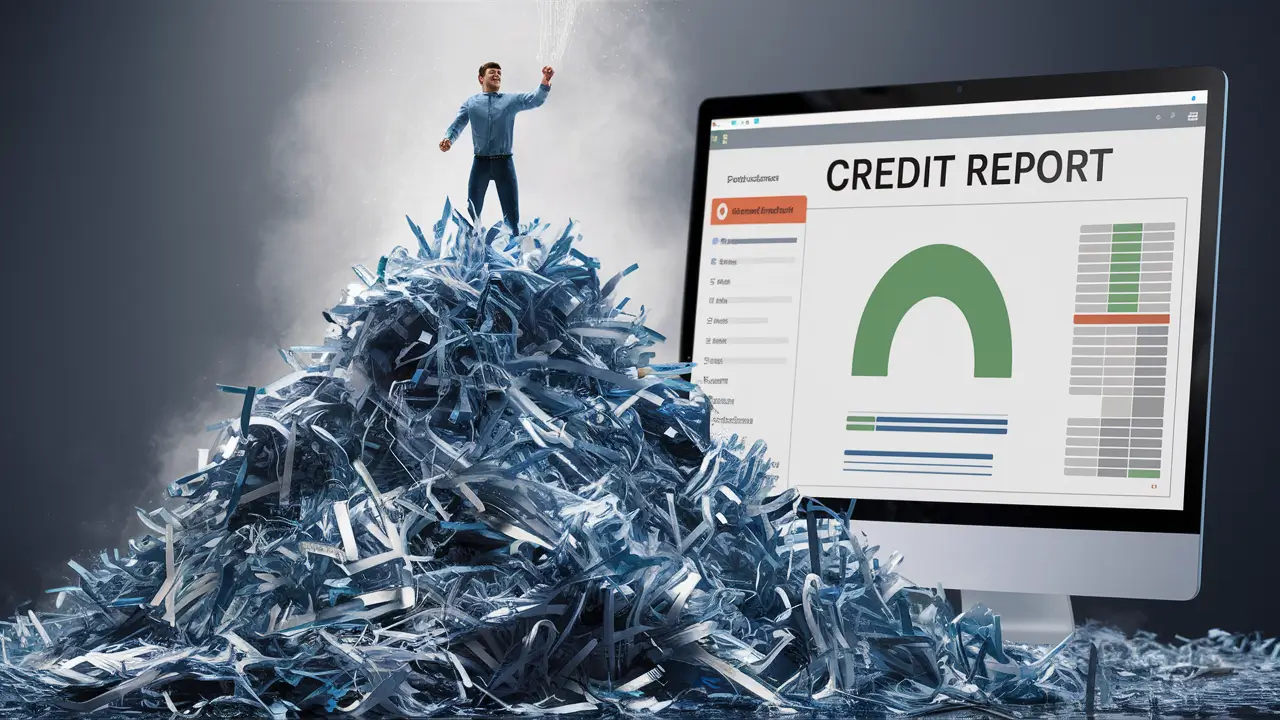-
Posted on: 25 Jul 2024

-
Your credit report is a vital document that significantly impacts your financial life. It's a record of your credit history, including your payment history, credit accounts, and any public records. Negative items on your credit report, such as late payments, collections, charge-offs, and bankruptcies, can severely damage your credit score, making it harder to get approved for loans, rent an apartment, or even secure a job. Fortunately, you're not powerless against inaccurate or unfairly reported negative information. This guide provides a step-by-step approach to understanding and removing negative items from your credit report.
Understanding Your Credit Report
Before you can begin the process of removing negative items, it's crucial to understand what a credit report is and the factors that influence your credit score.
What is a Credit Report?
A credit report is a detailed record of your credit history compiled by credit reporting agencies (also known as credit bureaus). The three major credit bureaus in the United States are:
- Equifax
- Experian
- TransUnion
These bureaus collect information from lenders, creditors, and public records to create your credit report. This report contains information such as:
- Personal Information: Name, address, Social Security number, and date of birth.
- Credit Accounts: Details of your credit cards, loans, and other credit lines, including account balances, payment history, and credit limits.
- Public Records: Bankruptcies, tax liens, and judgments.
- Inquiries: A record of who has accessed your credit report.
Why is Your Credit Score Important?
Your credit score is a three-digit number calculated based on the information in your credit report. It's used by lenders and other businesses to assess your creditworthiness. A good credit score can help you:
- Get approved for loans and credit cards.
- Secure lower interest rates.
- Rent an apartment.
- Obtain insurance.
- Get hired for certain jobs.
A poor credit score, on the other hand, can lead to higher interest rates, denial of credit, and other financial difficulties.
Step-by-Step Guide to Removing Negative Items
Here's a detailed guide on how to remove negative items from your credit report:
1. Obtain Copies of Your Credit Reports
The first step is to obtain copies of your credit reports from all three major credit bureaus. You can get a free copy of your credit report from each bureau once a year by visiting AnnualCreditReport.com. This is the only authorized website for free credit reports.
Alternatively, you can contact each credit bureau directly:
- Equifax: Equifax.com
- Experian: Experian.com
- TransUnion: Transunion.com
2. Review Your Credit Reports Carefully
Once you have your credit reports, review them carefully for any inaccuracies, errors, or outdated information. Common errors include:
- Incorrect Personal Information: Wrong name, address, or Social Security number.
- Accounts That Don't Belong to You: Accounts that you never opened.
- Incorrect Account Balances: Balances that are higher or lower than they should be.
- Late Payments Reported Incorrectly: Payments that you made on time but were reported as late.
- Duplicate Accounts: The same debt listed multiple times.
- Outdated Information: Negative items that are older than seven years (ten years for bankruptcies).
Make a list of all the errors you find and gather any supporting documentation, such as payment records, account statements, or identity verification documents.
3. Dispute Inaccurate Information with the Credit Bureaus
If you find errors on your credit report, you have the right to dispute them with the credit bureaus. Under the Fair Credit Reporting Act (FCRA), credit bureaus are required to investigate your disputes within 30 days.
To file a dispute, you can use the credit bureau's online dispute portal, or send a dispute letter by certified mail. Your dispute letter should include:
- Your full name and address.
- Your date of birth and Social Security number.
- A copy of your credit report with the disputed items circled.
- A clear explanation of why you believe the information is inaccurate.
- Supporting documentation to back up your claim.
- A request that the credit bureau investigate the disputed information and correct or remove it.
Here are the addresses for sending dispute letters to each credit bureau:
- Equifax: P.O. Box 740256, Atlanta, GA 30374
- Experian: P.O. Box 4500, Allen, TX 75013
- TransUnion: P.O. Box 2000, Chester, PA 19016
It's important to send a separate dispute letter to each credit bureau, even if the same error appears on multiple reports. Keep copies of all your correspondence for your records.
4. The Credit Bureau Investigation
Once the credit bureau receives your dispute, they will forward it to the creditor that reported the information. The creditor will then investigate the dispute and provide documentation to the credit bureau to support their claim.
Within 30 days, the credit bureau must notify you of the results of their investigation. If the credit bureau finds that the information is inaccurate, they are required to correct or remove it from your credit report. If they verify the information, it will remain on your credit report.
5. Re-Dispute Verified Information if Necessary
If the credit bureau verifies the disputed information, but you still believe it is inaccurate, you have the right to re-dispute it. When re-disputing, provide new evidence or arguments that were not included in your original dispute. You can also contact the creditor directly to try to resolve the issue.
If you are still unable to get the negative item removed, you can add a statement to your credit report explaining the situation. This statement will be included whenever your credit report is accessed by lenders or other businesses.
6. Consider a "Pay-for-Delete" (Use with Caution)
A "pay-for-delete" is an agreement with a collection agency or creditor to remove a negative item from your credit report in exchange for payment. While this may seem like a quick fix, it's important to proceed with caution. Not all creditors are willing to enter into pay-for-delete agreements, and even if they agree, there's no guarantee that they will follow through.
Before entering into a pay-for-delete agreement, get the agreement in writing from the creditor. Make sure the agreement clearly states that the creditor will remove the negative item from your credit report once you make the payment. If the creditor does not remove the item as agreed, you can file a complaint with the Consumer Financial Protection Bureau (CFPB).
Keep in mind that even if you successfully remove a collection account through a pay-for-delete agreement, the underlying debt may still be valid. You may need to negotiate a settlement with the creditor to resolve the debt.
7. Debt Validation (For Collection Accounts)
If you have a collection account on your credit report, you have the right to request debt validation from the collection agency. Under the Fair Debt Collection Practices Act (FDCPA), collection agencies are required to provide you with certain information about the debt, including:
- The name of the original creditor.
- The amount of the debt.
- A statement that you have 30 days to dispute the validity of the debt.
If the collection agency cannot provide this information, or if they provide inaccurate information, you can demand that they remove the collection account from your credit report. To request debt validation, send a written request to the collection agency within 30 days of receiving their initial communication.
8. Be Patient and Persistent
Removing negative items from your credit report can take time and effort. It's important to be patient and persistent throughout the process. Keep detailed records of all your correspondence with the credit bureaus and creditors. If you encounter any difficulties, don't hesitate to seek help from a credit counseling agency or a consumer protection organization.
Strategies for Avoiding Negative Items in the Future
While it's important to address existing negative items on your credit report, it's even more important to prevent them from occurring in the first place. Here are some tips for maintaining a positive credit history:
- Pay your bills on time: Payment history is the most important factor in your credit score.
- Keep your credit card balances low: Aim to keep your credit utilization ratio (the amount of credit you're using compared to your credit limit) below 30%.
- Don't open too many new accounts at once: Opening multiple accounts in a short period of time can lower your credit score.
- Monitor your credit reports regularly: Check your credit reports from all three credit bureaus at least once a year to identify any errors or potential fraud.
When to Seek Professional Help
While you can remove negative items from your credit report on your own, there are situations where it may be beneficial to seek professional help. Consider hiring a credit repair company or consulting with a credit counselor if:
- You're overwhelmed by the process and don't know where to start.
- You have a complex credit history with multiple negative items.
- You've been the victim of identity theft or fraud.
- You're struggling to manage your debt and need help with budgeting or debt consolidation.
Be sure to choose a reputable credit repair company or credit counselor with a proven track record. Avoid companies that make unrealistic promises or charge excessive fees.











